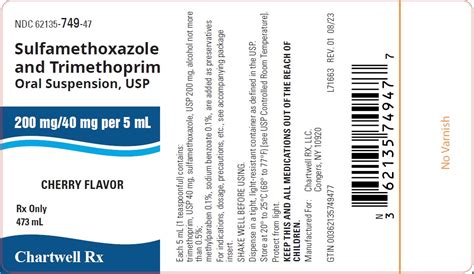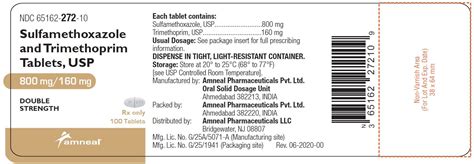Intro
The combination of trimethoprim and sulfamethoxazole is a widely used antibiotic for treating various bacterial infections. This medication is effective against a range of bacteria, including those that cause urinary tract infections, respiratory infections, and skin infections. Understanding the proper dosage of trimethoprim/sulfamethoxazole is crucial for ensuring its effectiveness and minimizing potential side effects.
The importance of accurate dosage cannot be overstated. Taking too little of the medication may not adequately clear the infection, while taking too much can increase the risk of side effects. The dosage of trimethoprim/sulfamethoxazole is typically determined by the type and severity of the infection being treated, as well as the patient's age, weight, and kidney function. It's essential for patients to follow the dosage instructions provided by their healthcare provider to ensure the best possible outcome.
Infections treated with trimethoprim/sulfamethoxazole can vary significantly in their severity and impact on the patient's quality of life. For instance, urinary tract infections can cause significant discomfort and, if left untreated, can lead to more severe complications such as kidney damage. Respiratory infections, like pneumonia, can also have serious consequences, especially in vulnerable populations such as the elderly or those with compromised immune systems. The appropriate use of trimethoprim/sulfamethoxazole, based on its recommended dosage, plays a critical role in managing these conditions effectively.
Introduction to Trimethoprim/Sulfamethoxazole

Trimethoprim/sulfamethoxazole works by inhibiting the growth and reproduction of bacteria. Trimethoprim interferes with the production of tetrahydrofolic acid, a compound necessary for the synthesis of DNA and proteins in bacteria. Sulfamethoxazole competes with para-aminobenzoic acid (PABA), a substrate used by bacteria to produce folic acid, which is essential for bacterial growth. By combining these two mechanisms, trimethoprim/sulfamethoxazole effectively prevents bacterial replication and clears infections.
Dosage Guidelines

The dosage of trimethoprim/sulfamethoxazole can vary based on the specific infection being treated. For adults, the typical dosage for uncomplicated urinary tract infections is 160mg/800mg (trimethoprim/sulfamethoxazole) taken orally every 12 hours for 3 days. For more severe infections, such as pneumonia, the dosage may be increased to 160mg/800mg every 12 hours for 10 to 14 days. It's crucial to complete the full course of treatment as prescribed, even if symptoms improve before finishing the medication.
Special Considerations
For patients with kidney impairment, the dosage may need to be adjusted to prevent accumulation of the drug and potential toxicity. The dosage for children is typically based on the child's weight, with the recommended dose being 8-10 mg/kg/day of trimethoprim and 40 mg/kg/day of sulfamethoxazole, given in two divided doses every 12 hours.Benefits of Trimethoprim/Sulfamethoxazole

The combination of trimethoprim and sulfamethoxazole offers several benefits, including its broad spectrum of activity against both Gram-positive and Gram-negative bacteria. It is also relatively inexpensive compared to other antibiotics, making it a cost-effective option for treating bacterial infections. Additionally, trimethoprim/sulfamethoxazole can be administered orally, which is more convenient for patients than intravenous antibiotics.
Common Uses
Trimethoprim/sulfamethoxazole is commonly used for: - Urinary tract infections - Respiratory infections such as bronchitis and pneumonia - Skin and soft tissue infections - Prophylaxis against Pneumocystis jirovecii pneumonia in patients with HIV/AIDSPotential Side Effects

While trimethoprim/sulfamethoxazole is generally well-tolerated, it can cause side effects in some patients. Common side effects include nausea, vomiting, diarrhea, and rash. More severe but less common side effects can include allergic reactions, liver damage, and blood disorders. It's essential for patients to be aware of these potential side effects and to seek medical attention if they experience any severe reactions.
Minimizing Side Effects
To minimize the risk of side effects, patients should: - Take the medication with food to reduce gastrointestinal upset - Stay hydrated to help prevent kidney stones - Monitor for signs of allergic reactions, such as rash or difficulty breathing - Regularly review their medication regimen with their healthcare providerInteractions with Other Medications

Trimethoprim/sulfamethoxazole can interact with other medications, including blood thinners, diabetes medications, and methotrexate. These interactions can increase the risk of side effects or reduce the effectiveness of the medications. Patients should inform their healthcare provider about all medications, vitamins, and supplements they are taking to avoid potential interactions.
Contraindications
Trimethoprim/sulfamethoxazole is contraindicated in patients with a known hypersensitivity to trimethoprim, sulfamethoxazole, or other sulfonamides. It should also be used with caution in patients with severe kidney or liver impairment, and in those with glucose-6-phosphate dehydrogenase (G6PD) deficiency due to the risk of hemolysis.Conclusion and Future Directions

In conclusion, trimethoprim/sulfamethoxazole is an effective and widely used antibiotic for treating various bacterial infections. Its proper dosage and potential side effects should be carefully considered to ensure effective treatment and minimize risks. As antibiotic resistance continues to be a global health concern, the responsible use of trimethoprim/sulfamethoxazole and other antibiotics is crucial for preserving their effectiveness for future generations.
Final Thoughts
The future of antibiotic therapy will likely involve the development of new antibiotics and strategies to combat resistance. In the meantime, medications like trimethoprim/sulfamethoxazole will continue to play a vital role in managing bacterial infections. By understanding the proper use, benefits, and potential risks of trimethoprim/sulfamethoxazole, healthcare providers and patients can work together to ensure the best possible outcomes.What is the typical dosage of trimethoprim/sulfamethoxazole for an adult with a urinary tract infection?
+The typical dosage for an uncomplicated urinary tract infection is 160mg/800mg (trimethoprim/sulfamethoxazole) taken orally every 12 hours for 3 days.
Can trimethoprim/sulfamethoxazole be used in patients with kidney impairment?
+Yes, but the dosage may need to be adjusted to prevent accumulation of the drug and potential toxicity. The adjustment should be made based on the patient's creatinine clearance.
What are common side effects of trimethoprim/sulfamethoxazole?
+Common side effects include nausea, vomiting, diarrhea, and rash. More severe but less common side effects can include allergic reactions, liver damage, and blood disorders.
We invite you to share your thoughts and experiences with trimethoprim/sulfamethoxazole in the comments below. If you found this article informative, please consider sharing it with others who might benefit from this information. Your engagement and feedback are invaluable to us, and we look forward to hearing from you.
